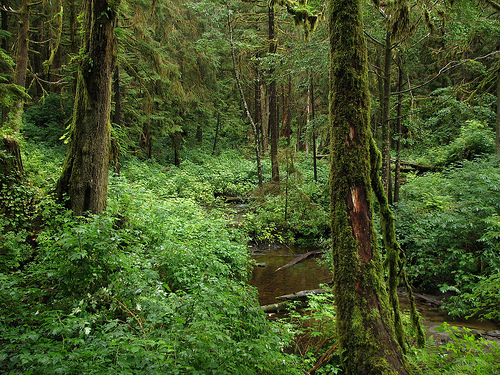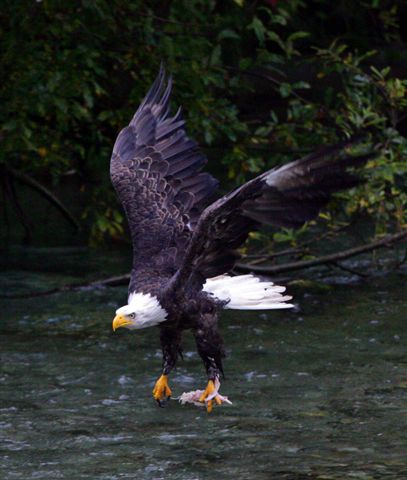Federal Court Halts Timber Suit In Alaska’s Tongass National Forest
February 17th, 2010

The impenetrable low-elevation interior of the Tongass National Forest.
In a region which has seen little positive news in the fight to save stands of old-growth forest on public land, some good news came today as a federal judge in Alaska threw out a lawsuit filed by a timber industry coalition which would have led to significant logging of ancient forest areas in the Tongass National Forest.
The Tongass is a 1,000-mile arc of temperate rainforest along Alaska’s southeast coast stretching from Ketchikan to Kodiak, containing some of the most intact, oxygen-generating and climate-regulating forest on the planet.

A black bear in the Tongass seizes lunch.
The largest National Forest in the U.S., the Tongass has long been the home to a prodigious timber industry, which has slowly nibbled inland from coves and inlets to a rich timber interior, and in some cases, has deforested whole islands just offshore or in bays and sounds along the mainland.
According to a Matthew Daly piece filed with the Associated Press on February 17th:
U.S. District Judge John Bates Wednesday dismissed a lawsuit filed by a timber group and an organization of Southeast Alaska civic and business leaders. The Southeast Conference and Alaska Forest Association had challenged a 2008 management plan for the Tongass developed by the Bush administration.
Environmental groups hailed the ruling as a small victory, saying the judge had prevented what they consider a bad forest plan from becoming even worse. Those groups say the Bush plan does not do enough to protect old-growth reserves and sites that are sacred to Alaska Native tribes.
The Associated Press piece goes on to quote Tom Waldo, an attorney for the environmental group Earthjustice, who described the manner in which industry groups were positioning their case so as to keep additional forest lands, including areas of old-growth, off-limits for protection.
“This was an attempt by the timber industry to take a bad forest plan and make it even worse,” Waldo said, adding that the judge’s ruling kept that from happening.
At more than 26,000 square miles, the Tongass is about the same size as West Virginia and is often labeled the “crown jewel” in the national forest system.
The Bush plan leaves about 3.4 million acres of the 17-million acre forest open to logging and other development, including about 2.4 million acres of backcountry areas that are remote and roadless. About 663,000 acres are in areas considered most valuable for timber production.
The lawsuit’s origins date back to a forest plan established for the Tongass during the Bush administration’s first term, which called for an increase in the volume of old-growth timber “harvests” to 1970s levels, an era which saw about 70% of the region’s old-growth forest logged.
However, it wasn’t the Bush administration, but the Obama administration which green-lighted a major old-growth timber harvest this past summer, when Secretary of Agriculture Tom Vilsack approved a 381-acre clearcut in the largest stand of temperate rain forest in the U.S.
According to the Southeast Alaska Conservation Council, this timber sale, and others like it over the past several years, was in part enabled by the Bush administration plan, which also called for significant amounts of subsidized logging, a practice often criticized in large Forest Service timber sales:
An appropriations bill rider [which] required all timber sales on the Tongass must be positive sales, meaning, no sales could be sold which undervalued the “stumpage” rate, or the value of trees as established by the marketplace. However, the Forest Service also conducts NEPA analyses, layout, and administrative operations to support these sales, and as such, the government does not make a profit overall.
Given the guaranteed low prices during contract days and the continued high cost of logging in Southeast Alaska today, one analysis concludes that, since 1980, the forest service has lost over a billion dollars in Tongass timber sales.
While we at Treehuggers International champion the preservation of ancient forests, we are not anti-logging or anti-timber. We recognize the clear necessity for paper and wood products and are aware of the obvious abundance of renewable North American forests. However, we take issue with reckless or wholesale clear-cutting of old-growth forest, especially on public lands in which taxpayers are entitled to a say, and ultimately, a “piece of the action” if our lands are to be destroyed or sold off for short-term financial gain, but leaving the public long-term clearcut scars and related environmental impacts.
The benefits of leaving old-growth areas “as is” for the purpose of good environmental health, clear air, and clean water are well-documented, and we feel there is far and away enough second and third generation forest currently on private and public lands suitable to fill the current demand for wood-related products.
(story-related weblinks to come, please check back)

Bald eagles are abundant in the Tongass rainforest.




